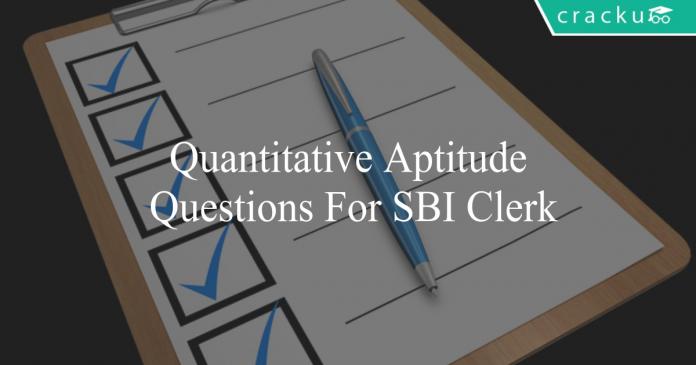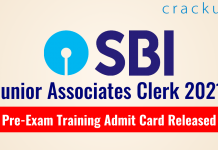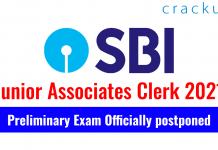Quantitative Aptitude Questions For SBI Clerk
Download SBI Clerk Quantitative Apptitude Questions & Answers PDF for SBI Clerk Prelims and Mains exam. Very Important SBI Clerk Quantitative Aptitude questions with solutions.
Download Quantitative Aptitude Questions For SBI Clerk
790+ Mocks – Just Rs. 194. Use coupon: SBIDREAM70
Download SBI Clerk Puzzles Set-1 PDF
Question 1: The ratio of 3rd and 6th term of a GP is 27. If the first term of the GP is 10, then find out the sum of infinite terms of this convergent GP.
a) 30
b) 40
c) 15
d) 20
e) 25
Question 2: Sum of the first 3 terms of an AP is 2/9 times the sum of first 6 terms of the same AP. Find out the ratio of first term to the common difference of the same AP.
a) 3 : 8
b) 1 : 4
c) 2 : 7
d) 1 : 3
e) 1 : 5
Question 3: N is a number that leaves the same remainder on dividing 2527, 2419, 2383, and 2599. The largest value of N that satisfies the condition is
a) 54
b) 18
c) 72
d) 36
e) 90
Download SBI Clerk Previous Papers PDF
Take a free mock test for SBI Clerk
Instructions
In each of the following questions a question is asked followed by three statements.You have to study the questions and all the given three statements and all the statements and decide whether any information provided in the statement are redundant and can be dispensed with while answering the questions ?
Question 4: What will be the cost of the painting the four walls of a room with length ,width and height is 5,3,8 meters respectively. The room has one window and one door.
I.Cost of painting per square meter is Rs 25
II.Area of window is 2.25 sq m which is half of the area of the door
III.Area of the room is 15 sq meter
a) I only
b) II only
c) III only
d) II or III only
e) All are required to answer the question
Question 5: How much time will the train X take to cross another train Y running in the opposite direction ?
I.Train X crosses a signal pole in 6 secs
II.Ratio of the speeds of trains X and Y is 3:2
III.Length of the two trains together is 500 meters
a) I only
b) II only
c) III only
d) I or II only
e) Data inadequate
Question 6: Three friends X,Y,Z started a partnership business investing money in the ratio of the 5 :4:2 respectively for a period of 3 years.What is the amount received by X as share in the total profit ?
I.Total amount invested in the business is Rs.22,000
II.Profit was distributed after a period of 2 years
III.The average amount of profit earned per year is Rs 2,750
a) I only
b) II only
c) III Only
d) I and II only
e) I or II or III
Question 7: Ram purchased three variety of barley at Rs. 100 per kg, Rs. 140 per kg and Rs. 180 per kg respectively. In what ratio he should mix these three varieties in that order so that the average cost of the mixture is Rs. 150 per kg?
a) 2 : 4 : 7
b) 1 : 5 : 10
c) 1 : 2 : 3
d) 2 : 5 : 5
e) None of the above
Banking Study Material – 18000 Questions
Question 8: Ram mixes acid and water in 3:5 to get solution X whereas he mixes water and acid in 2:3 to get solution Y. In what ratio he should mix solution X and Y to make another solution which contains 50% acid?
a) 3 : 5
b) 4 : 5
c) 5 : 4
d) 5 : 3
e) 1 : 1
Question 9: Jar A contains 70% milk and the rest is water whereas Jar B contains 60% water and the rest is milk. How many liters of solution A should be mixed with 100 liters of solution B to make 50% water-milk solution?
a) 20
b) 100
c) 80
d) 40
e) 50
Instructions
In the following questions 2 quantities X and Y are given. Select the option which best captures the relations between X and Y.
Question 10: 3 dices are thrown.
X is the probability that sum of the number on the faces of the dice is 7.
Y is the probability that sum of the number on the faces of the dice is 14.
a) X>Y
b) X<Y
c) X$\geq$Y
d) X$\leq$Y
e) X=Y or Cannot be determined
Question 11: Solution A has p and q in the ratio 1:2. Solution B has p and q in the ratio 5:4. Solution A and Solution B are mixed in the ratio 3:4 to form the solution C. Solution A and Solution B are mixed in the ratio 5:3 to form the solution D.
X = the ratio of p and q in Solution C
Y = the ratio of p and q in Solution D.
a) X>Y
b) X
c) X$\geq$Y
d) X$\leq$Y
e) X=Y or Cannot be determined
Question 12: Cost price of 6 articles is equal to the Selling price of 4 articles. The shopkeeper Marked up the price by 100%. X is the % discount offered.
Y is the % profit obtained.
a) X>Y
b) X<Y
c) X$\geq$Y
d) X$\leq$Y
e) X=Y or Cannot be determined
Question 13: To meet the demand during summer, a milkman mixed water with pure milk in 2:5. Then he sold the same mixture at 20% more than normal price. By what percent his revenue will increase during summers? (Water is available without any cost)
a) 60 percent
b) 50 percent
c) 40 percent
d) 68 percent
e) 63 percent
Question 14: A retailer bought 5 dozen notebooks. He got these notebooks at 30% less than printed price. To clear his stock soon he offered 1 notebook free on buying 4 notebooks. If the retailer sold all notebooks on printed price, what’s is retailer’s profit percentage in this transaction?
a) 28.57%
b) 21.35%
c) 12.48%
d) 42.89%
e) 14.28%
Question 15: Krishna purchased a new laptop. After 2 years, he sold it to Pradeep at a discount of 30% when compared to the actual cost price. Pradeep spent 680 for repairing the laptop after purchase. After using it for 2 years, he sold it to Ravi at a discount of 30% when compared to the total amount he invested in the laptop. If Ravi paid exactly half the amount which Krishna paid, find the amount that Krishna paid when he purchased the laptop?
a) 47600
b) 36600
c) 68000
d) 72000
e) None of the above.
Instructions
One of the numbers in the given series is incorrect. Find the incorrect number in the series
Question 16: 7, 33, 137, 553, 2217, 8871
a) 33
b) 137
c) 553
d) 8871
e) 2217
Question 17: 6, 12, 15, 30, 42, 56
a) 12
b) 30
c) 6
d) 56
e) 15
Question 18: 6, 19, 58, 172, 526
a) 172
b) 58
c) 19
d) 526
e) 6
Question 19: 5 bottles of apple juice and 9 bottles of mango juice together fill 71 glasses. Also, 7 bottles of apple juice and 11 bottles of mango juice together fill 93 glasses. How many glasses can be filled with 3 bottles of apple juice and 4 bottles of mango juice if each bottle of either of the juices fills an integer number of glasses?
a) 37
b) 41
c) 34
d) 45
e) 32
Question 20: An ATM machine contains 100 notes. The notes are of Rs. 5, Rs. 10 and Rs. 20 denominations. The total value of the notes in the machine is Rs.1500. If the number of Rs.10 and Rs. 20 notes is exchanged, the net value goes down by Rs. 400. The number of 20 rupee notes in the machine is
a) 10
b) 20
c) 40
d) 60
e) 80
General Knowledge Questions & Answers PDF
Answers & Solutions:
1) Answer (C)
Let ‘r’ be the common ratio of the given GP.
The ratio of 3rd and 6th term of a GP is 27.
$\dfrac{ar^2}{ar^5}$ = 27
$\Rightarrow$ $\dfrac{1}{r^3}$ = 27
$\Rightarrow$ $r = \dfrac{1}{3}$
Sum of infinite GP = $\dfrac{a}{1-r}$ = $\dfrac{10}{1-1/3}$ = 15
Hence, option C is the correct answer.
2) Answer (E)
Let ‘a’ and ‘d’ be the first term and common difference of the given AP.
$\Rightarrow$ $\dfrac{3}{2}(2a + 2d) = \dfrac{2}{9}[\dfrac{6}{2}(2a + 5d)]$
$\Rightarrow$ $3a+3d = \dfrac{2}{3}(2a + 5d)$
$\Rightarrow$ $9a+9d = 4a + 10d$
$\Rightarrow$ $5a = d$
$\Rightarrow$ $\dfrac{a}{d} = \dfrac{1}{5}$
Therefore, option E is the correct answer.
3) Answer (D)
N leaves the same remainder on dividing 2527, 2419, 2383, and 2599, the difference between any pair of these numbers should be divisible by the number. The smallest difference will be the limiting factor.
2599 – 2527 = 72
2599- 2419= 180
2599-2383= 216
2527- 2419= 108
2527- 2383= 144
2419- 2383= 36
As we can see, 36 is the smallest difference and hence, the largest number that satisfies the given condition is 36.
Therefore, option D is the right answer.
4) Answer (C)
Length = 5 m , Breadth = 3 m and Height = 8 m
To find the cost of painting the walls of the room, we should know the cost of painting and the area of door and window.
Area of 4 walls (Curved Surface Area of cuboid) = $2h(l+b)$
= $(2 \times 8)(5+3) = 16 \times 8 = 128$ $m^2$
From I & II : Cost = Rs 25 per square meter
Area of window = $2.25$ $m^2$
and Area of door = $2 \times 2.25 = 4.5$ $m^2$
Thus, area to be painted = $128 – 2.25 – 4.5 = 121.25$ $m^2$
$\therefore$ Cost of painting 4 walls = $25 \times 121.25 = Rs$ $3031.25$
Thus, statement III is redundant.
=> Ans – (C)
5) Answer (E)
To find the time taken by train X to cross train Y, we should know the sum of speed of the trains (as they are moving in opposite directions) and the sum of lengths of the train
In statement II, ratio of speed of train X : Y = 3 : 2
Thus, we cannot find the speeds of the two trains.
$\therefore$ Data is inadequate
=> Ans – (E)
6) Answer (D)
Ratio of investment of X : Y : Z = 5 : 4 : 2
To find the share of profit earned by X (or anyone), we need to find the total profit earned.
From statement III : Average profit for 3 years = Rs. 2750
=> Total profit = $2750 \times 3$ = Rs. 8250
Amount received by X = $\frac{5}{(5+4+2)} \times 8250$ = Rs. 3750
Thus, statements I and II are redundant.
=> Ans – (D)
7) Answer (D)
Let us check the options.
Option (A): Average cost price of the mixture = $\dfrac{200+560+1260}{2+4+7}$ = Rs. 155.38
Option (B): Average cost price of the mixture = $\dfrac{100+700+1800}{1+5+10}$ = Rs. 162.50
Option (C): Average cost price of the mixture = $\dfrac{100+280+540}{1+2+3}$ = Rs. 153.33
Option (D): Average cost price of the mixture = $\dfrac{200+700+900}{2+5+5}$ = Rs. 150
Therefore, option D is the correct answer.
8) Answer (B)
Let ‘a’ and ‘b’ be the quantity of solution X and Y mixed by Ram. It is given that the solution contains 50% acid hence,
$\Rightarrow$ $\dfrac{\dfrac{3a}{8}+\dfrac{3b}{5}}{a+b} = \dfrac{50}{100}$
$\Rightarrow$ $\dfrac{15a+24b}{40(a+b)} = \dfrac{1}{2}$
$\Rightarrow$ $30a+48b = 40a+40b$
$\Rightarrow$ $\dfrac{a}{b} = \dfrac{4}{5}$
Hence, option B is the correct answer.
9) Answer (E)
Let ‘X’ liters of solution A is mixed with 100 liters of solution B.
Concentration of milk in solution B = 100 – 60 = 40%.
The resultant solution is a 50% water-milk solution.
Hence,
$\dfrac{0.70*X + 0.40*100}{X+100} = \dfrac{50}{100}$
$70*X + 4000 = 50*X + 5000$
$20X= 1000$
$X= 50$liters.
Hence, option E is the correct answer.
10) Answer (E)
7 = 1 + 1 + 5 = 2 + 2 + 3 = 3 + 3 + 1 = 1 + 2 + 4
Thus, the probability that sum of the number on the faces of the dice is 7 = (3C1+3C1+3C1+3!)/216 = 15/216 = X
10 = 6 + 3 + 1 = 6 + 2 + 2 = 5 + 3 + 2 = 4 + 4 + 2 = 4 + 3 + 3 = 1 + 4 + 5
Thus, the probability that sum of the number on the faces of the dice is 14 = (3C1+3C1+3C1+3!)/216 = 15/216 = Y
Hence, X=Y
Hence, option E is the correct answer.
11) Answer (A)
Let the quantity of A and B be 9L.
Thus, the amount of p and q in A is 3L and 6L respectively.
Also, the amount of p and q in B is 5L and 4L respectively.
A and B are mixed in the ratio 3:4 to form solution C.
Thus, the amount of p and q in solution C = (3*3+5*4):(6*3+4*4) = 29:34=X
Solution A and Solution B are mixed in the ratio 5:3 to form the solution D.
Thus, the amount of p and q in solution D = (5*3+5*3):(6*5+4*3) = 30:42=Y
Hence, X>Y
Hence, option A is the correct answer.
12) Answer (B)
Let the CP be 10 Rs.
Thus, 6*10 = 4*SP. Thus, SP = 15 Rs
MP = 2*10 = 20 Rs
% discount = $\frac{20-15}{20}$ = 25% = X
% profit = $\frac{15-10}{10}$ = 50% = Y
Hence, option B is the correct answer.
13) Answer (D)
Let us assume that on a normal day he sells milk at x rupee per litre and he sells y litre of milk
So revenue generated on normal day = x*y = xy
He mixed water with milk in ratio of 2:5 so net quantity = $\frac{2+5}{5} * y$ = 1.4y
New selling price during summer = 1.2x rupees per litre
So revenue generated in summers = 1.4y * 1.2x = 1.68xy
Hence we can say that revenue will go up by 68 percent.
14) Answer (E)
Number of notebooks that retailer bought = 5 * 12 = 60
Let us assume that printed price on each notebook = 100
The retailer bought these notebooks at 30% less = 70 Rupees/notebook
Sum invested by the retailer = 60*70 = 4200
By selling 60 notebooks he will get money for = $\frac{4}{5}*60$ = 48 notebooks
Money collected by the retailer by selling these notebooks = 48*100 = 4800
Hence, retailer’s profit percentage = $\frac{4800-4200}{4200}*100$ = 14.28%
15) Answer (A)
Let assume Krishna paid 100x when he purchased the laptop.
So Krishna sold it to Pradeep for = $\frac{100-30}{100}*100x$ = 70x
And Pradeep also spent 680 rupees for repairing
So total amount invested by Pradeep = 70x+680
So the amount Ravi paid to Pradeep = $\frac{100-30}{100}*(70x+680)$ = 49x+476
We also know that Ravi paid exactly half of what Krishna paid
i.e. 0.5*(100x) = 49x+476
$\Rightarrow$ x = 476
So the amount for which Krishna purchased the laptop = 100*476 = 47600
16) Answer (D)
7*4+5 = 28+5 = 33
33*4+5 = 132+5 = 137
137*4+5 = 548+5 = 553
553*4+5 = 2212+5 = 2217
2217*4+5 = 8868+5 = 8873
Hence, 8871 must be replaced by 8873
17) Answer (E)
2*3 = 6
3*4 = 12
Next term would be 4*5 = 20
5*6 = 30
6*7 = 42
7*8 = 56
Hence, 15 must be replaced by 20.
18) Answer (A)
The pattern being followed here is *3+1
6*3+1 = 19,
19*3+1=58,
so next term would be 58*3+1= 175
175*3+1 = 526.
Hence, 172 must be replaced by 175.
19) Answer (A)
Let 1 bottle of apple juice fill ‘a’ glasses and 1 bottle of mango juice fill ‘m’ glasses.
We have 5a + 9m = 71 and 7a + 11m = 93.
Solving we get a = 7 and m = 4.
So 3 bottles of apple juice and 4 bottles of mango juice will fill = 7*3 + 4*4 = 37 glasses
Hence, option A is the right choice.
20) Answer (D)
Let the number of 5 rupee notes be x, 10 rupee notes be y and 20 rupee notes be z.
We know that,
x + y + z = 100 ———————–(1)
5x + 10y + 20z = 1500————–(2)
5x + 20y + 10z = 1100————-(3)
Multiplying equation (1) by 5 and substituting it in equations (2) and (3), we get,
5y + 15z = 1000——-(4)
15y + 5z = 600 —-(5)
(4)*3 – (5) => 40z = 2400
z = 60
Therefore, the number of 20 rupee notes is 60.
Therefore, option D is the right answer.
We hope this Quantitative Aptitude Question & Answers PDF of SBI Clerk is very Useful for preparation of SBI Clerk Exams.





